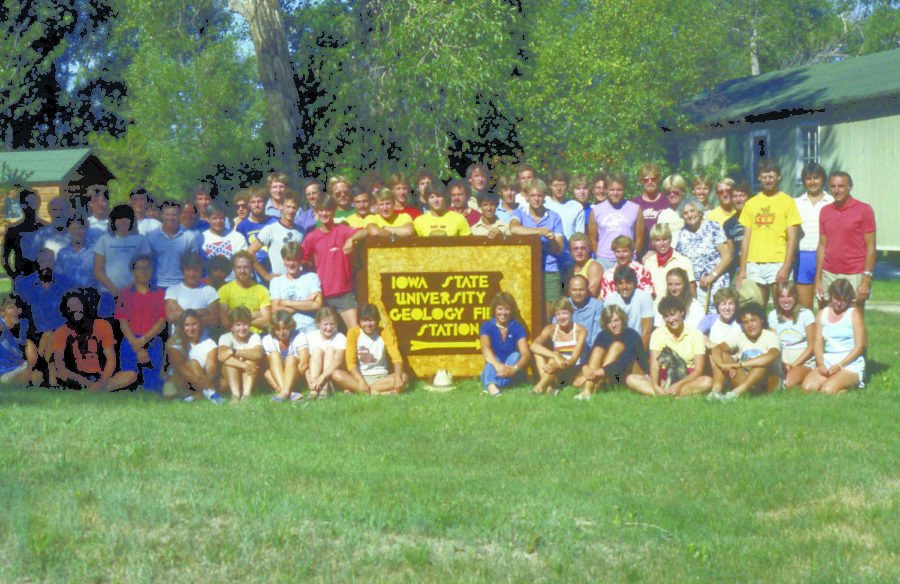Internment Camp building being used to house students
January 15, 2016
A piece of history has not only served as a reminder to the past as a place of learning for some ISU students.
The Iowa State University Carl F. Vondra Geology Field Station is west of the Bighorn Mountains in Wyoming and houses a diverse selection of rocks and geological formations. Here, geology students take part in an intensive six-week course to gain hands-on experience.
However, there is more to the story behind the station among the field of outcropping rocks.
The barracks where ISU students stayed while studying in Wyoming once were used to house interned Japanese Americans during World War II, by order of then-President Franklin D. Roosevelt in February 1942.
Today, the Japanese internment is widely considered a stain on American history.
After this order, about 120,000 people of Japanese ancestry living on the West Coast were evacuated and incarcerated in camps around the United States, according to PBS.org. Most of these people “were U.S. citizens or legal permanent resident aliens,” PBS.org stated.
There were 10 internment camps scattered throughout the western United States, including one about 80 miles from Heart Mountain. The internment camp, according to PBS.org, was opened in August 1942 and closed in November 1945. At its peak, the camp housed more than 10,000 individuals.
The executive order signed by Roosevelt was deemed a “military necessity to protect against domestic espionage and sabotage,” the site stated.
The barracks used to house the Japanese fell into the possession of various county, state and town officials after the war.
“We leased them from the city of Greybull, [Wyo.] for $1 a year,” said Carl Vondra, emeritus professor of geology and distinguished professor in liberal arts and sciences, and the namesake of the geology field station.
The government ended up giving a lot of the facilities away, Vondra said.
“Many of them were given to returning veterans and they used them as outhouses on their farms,” he said.
Mark Mathison, teaching lab coordinator for the department of geology, said there were about 750 buildings, which were sold off for $1 a piece.
The city of Greybull ended up buying three of them prior to the field camp.
The flood plains of Shell Creek near Shell, Wyo., was offered to the university at a below value price in 1957, said Aaron Wood, director of the Carl F. Vondra Field Station and lecturer in geology.
This became the home of the geology field camp.
The buildings, all located near Heart Mountain, were in bad physical condition, Vondra said. They had bad insulation and were more than 10 years old by the time they were leased to the field station in 1957.
“These buildings were cheaply and rapidly made back in World War II,” Wood said.
From 1964 until 2003, Vondra led the camp as its director. Vondra oversaw a lot of remodeling of the barracks during the time he was director of the camp.
Every summer, work was done on the building by students and faculty.
“They were not very livable at first,” Vondra said.
Mostly faculty worked on the buildings because the students were primarily doing field work.
After years of use and renovation, the Heart Mountain Wyoming Foundation was given the award for most historically accurate and preserved building. It can be seen on permanent display 13 miles east of Cody, Wyo. as a national historic landmark.
The most positive thing that can be taken from the whole matter to Mathison is that a large group of students were able to receive an education while living in the barracks. They got a chance to see a piece of history firsthand.
The field station is used for a required six-credit class, geology 302, for students majoring in geology. The goal of the course, which takes place during a course of six weeks, is to provide geology students the chance to get real-field experience.
The course can be considered intense by some; students work five and a half days a week.
“You’re basically immersed in the rocks,” Mathison said. “It’s a perfect classroom.”
Students are able to get hands-on experience with geological features around them.
“You’re getting a real idea of what field geology is like,” Mathison said. “There are very tough concepts that you’re working with.”
The field station is used by universities from surrounding states as well. The University of Nebraska works extensively at the field station, since the University of Nebraska at Lincoln is a partner university at the station.
The class’s student-to-teacher ratio usually falls at 10 or less students to one teacher.
The camp has changed throughout the years in many ways. One way in particular is the toliets; the station has only recently installed bathrooms with running water.
“We had outdoor toliets until I stepped down from the camp,” Vondra said. “I didn’t see the value of having porta-potties.”
Among the other amenities that have been added to the camp over the years are air conditioning and heat.
The students, however, have changed as well.
“The thing I noticed over the 40 years I was out there was a great change in the students,” Vondra said. “The intelligence of the students haven’t changed, but what students are willing to do has changed.”
Their attitudes and work ethics in particular have changed for the worst, he said. Physical labor is simply where students seem to be lacking.
“When you’re working in the field as a geologist you do a lot of hiking under very difficulty conditions,” Vondra said, since geologist often find themselves climbing and working in hot or extreme conditions.
The field station property is owned by the Iowa State University Foundation, and the Department of Geological Sciences runs the camp. The University of Nebraska of Lincoln’s geology department helps with a minor extent with the instruction.
The geology field station will welcome 40 students and six instructors from Iowa State this year between May 22 and July 1.

















